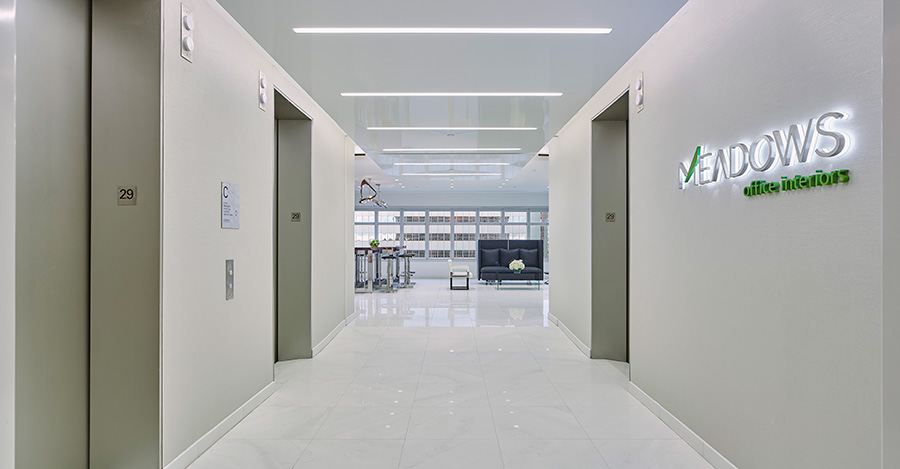Pictured above: One of Nokia collaborative areas at their UK HQ, (Photography by Will Pryce)
Offices are shifting from the individual based cubicle and private offices to common areas that allow employees to connect face-to-face. Whether a board meeting, daily sales huddle or one-on-one brainstorm session, leading organizations are providing the types of collaborative areas that employees want.
What features allow you to make the most out of these collaborative zones? Here’s a look at what organizations who are leading the way in collaborative workplace design are doing.
Casual Collaboration

The Library at Instagram’s London HQ (Photography: Christophe Wu)
Casual collaborative areas are the most sought after and Instagram has also done a tremendous job of making their collaborative areas feel casual.
One challenge designers face is maintaining the casual look while providing functionality. For example, a couch is casual but is it ergonomically sound for someone to use a laptop on one? Gensler worked with Instagram’s creative director Ian Spalter to create areas like the library. It’s a great example of supporting work needs with functional desk options that still provides a casual and blank canvas space for employees to be creative.
Other casual areas that exist throughout the space include a Blue Bottle coffee bar, design room for standing meetings, and micro-kitchens on each floor.
CBRE
Under CBRE’s new “Our future at work” program, employees can choose from 6 different work settings including added casual collaborative zones.
At their GTA West location, employees note that more casual collaboration is occurring outside of just meeting rooms as a result of the changes in design by HOK.
Informal areas include acoustic high back booth seating to create mini breakout zones. Other features include their own Rise cafe where employees can meet for work or a break.
Employees note that it has actually added to the culture they are aiming to create. It’s also proof that Cafe’s aren’t just for startups. Designers have realized the value of tapping into these areas where people naturally gravitate to interact with each other.
Using Tech to Make Collaboration Easier

Open office and collaborative area using Smart Glass for adjustable privacy (©David Paler Photography. All other rights, including but not limited to self-promotion usage, reserved)
Meadows Office Interiors
In their report on creating effective collaborative zones within the workplace Knoll highlights that: “Today’s collaborative spaces fall short of expectations, driven by a lack of spaces to support the most valued types of collaboration, and a lack of adaptability of both furnishings and technology within the spaces.”
Meadows’ office design is a perfect example of how to address these issues head on.
Meadows adds function to their collaborative areas with wireless charging that makes it easy for their employees or clients to stay connected and charge their smartphones during meetings.
They also feature meetings rooms with smart glass that allow privacy when required. The flexibility of this solution means however that natural light can flow in and openness can be promoted the rest of the time.
Rolling Collaboration

Deloitte’s Toronto Office features 18 different types of work zones include casual collaborative and client facing spaces like this one (Photography: James Brittain)
Deloitte
Deloitte’s Toronto headquarters provides maximum flexibility for collaboration. The space employs 18 different types of spaces to ensure that employees can choose the way to collaborate that best suits their needs.
To create collaboration almost any common area within the space can be used for teamwork. Employees can choose from multiple cafeterias, high top seating in the perimeter of the space, internal casual zones with couches and more.
Additionally, Deloitte employs a variety of meeting rooms in lieu of numerous private offices. These rooms range in size and most can accommodate 2 or more people.
To make it easy for these zones to be used, some are time barred and strictly non-reservable rooms. This means that when that casual collision does happen on their open staircase (another collaborative feature) for example, employees can take advantage of a nearby room to continue a discussion.
Nokia
As a phone manufacturer knows well, smart phones have changed the way that employees collaborate. The Finnish phone manufacturer designed their new London HQ to foster face-to-face collaboration and help bring employees back into the office.
Gensler highlights the fact that their design and strategy “established new ways of working for Nokia, creating flexible workspaces with a focus on the informal and accommodations for a range of group sizes and functions.”
The desired change was observed within even 2 weeks of the move, with occupancy doubling from the old location.




